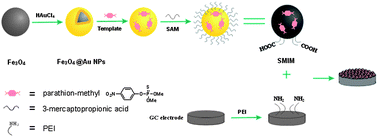Fe3O4@Au sphere molecular imprinting with self-assembled monolayer for the recognition of parathion-methyl†
Abstract
A novel surface molecular imprinting technique is reported based on spherical molecular imprinted monolayer (SMIM) prepared from

* Corresponding authors
a
Department of Chemistry and Shanghai Key Laboratory of Green Chemistry and Chemical Process, East China Normal University, 3663 Zhongshan Road(N), Shanghai, China
E-mail:
gyshi@chem.ecnu.edu.cn
Fax: +86-21-62237105
Tel: +86-21-62237105
b
Department of Environmental Science, East China Normal University, 3663 Zhongshan Road(N), Shanghai, China
Tel: +86-21-62238393
A novel surface molecular imprinting technique is reported based on spherical molecular imprinted monolayer (SMIM) prepared from

 Please wait while we load your content...
Something went wrong. Try again?
Please wait while we load your content...
Something went wrong. Try again?
X. Tang, D. Zhang, T. Zhou, D. Nie, Q. Yang, L. Jin and G. Shi, Anal. Methods, 2011, 3, 2313 DOI: 10.1039/C1AY05279A
To request permission to reproduce material from this article, please go to the Copyright Clearance Center request page.
If you are an author contributing to an RSC publication, you do not need to request permission provided correct acknowledgement is given.
If you are the author of this article, you do not need to request permission to reproduce figures and diagrams provided correct acknowledgement is given. If you want to reproduce the whole article in a third-party publication (excluding your thesis/dissertation for which permission is not required) please go to the Copyright Clearance Center request page.
Read more about how to correctly acknowledge RSC content.
 Fetching data from CrossRef.
Fetching data from CrossRef.
This may take some time to load.
Loading related content
